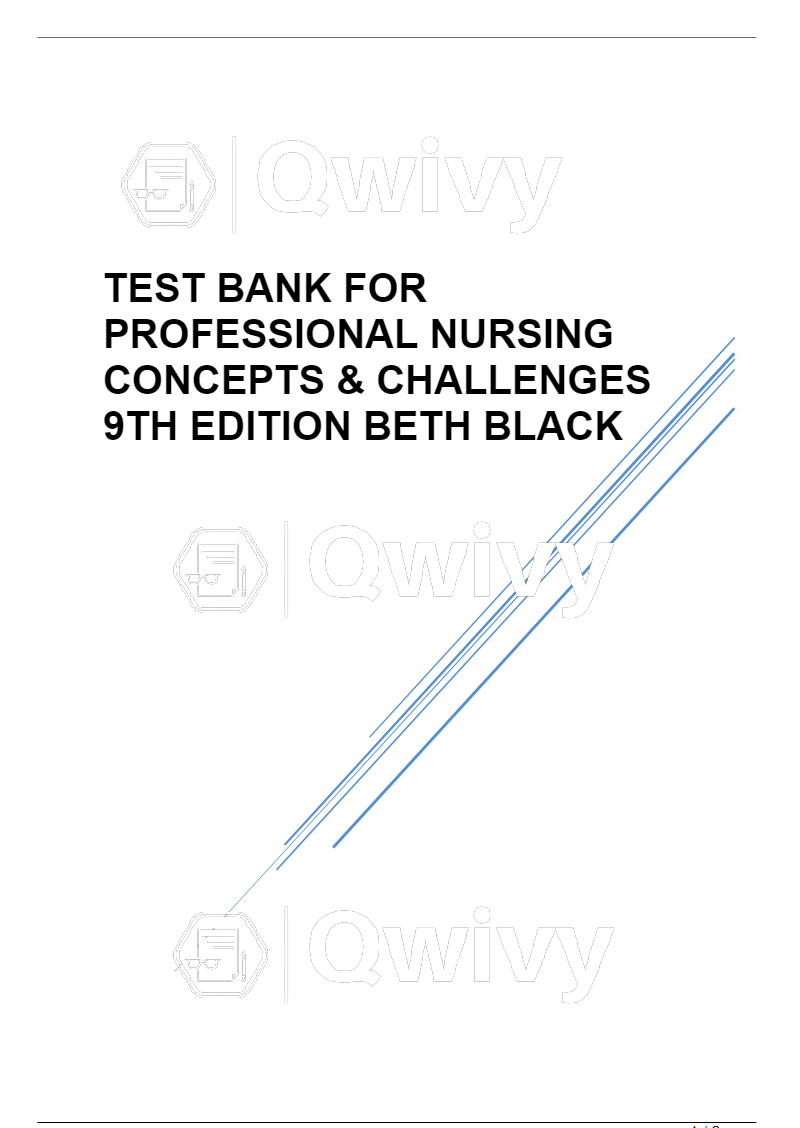
Psychopharmacology Drugs the Brain and Behavior 3rd Edition Meyer Test Bank Latest 2021-2022
Test Bank
to accompany
Psychopharmacology, Third Edition
Meyer • Quenzer
Chapter 1: Principles of Pharmacology
Multiple Choice
1. _______ refer(s) to specific molecular changes that occur when a drug binds to a
particular target site or receptor, while _______ are the resulting widespread alterations
in function.
a. Drug action; therapeutic effects
b. Side effects; drug effects
c. Therapeutic effects; side effects
d. Drug action; drug effects
Answer: d
Textbook Reference: Pharmacology: The Science of Drug Action
2. After drug administration has occurred, the amount of drug in the blood that is free to
bind at specific target sites is referred to as
a. the therapeutic dose.
b. first-pass effects.
c. bioavailability.
d. ED50.
Answer: c
Textbook Reference: Pharmacokinetic Factors Determining Drug Action
3. The specific molecular changes that occur when a drug binds to a particular target site
or receptor are referred to as
a. drug effects.
b. drug action.
c. side effects.
d. placebo effects.
Answer: b
Textbook Reference: Pharmacology: The Science of Drug Action
4. Which of the following is not a possible explanation for placebo effects?
a. Pavlovian conditioning
b. Genetic variation
c. Drug competition
d. Expectation of outcome
Answer: c
Textbook Reference: Pharmacology: The Science of Drug Action
WWW.qwivy.COM
Page 1 of 247
https://qwivy.com/products/psychopharmacology-drugs-the-brain-and-behavior-3rd-edition-meyer-test-bank
WWW.qwivy.COM
1 / 4
5. The _______ administration of oxytocin has been proposed as a treatment for autism.
a. intravenous
b. oral
c. intranasal
d. intracerebral
Answer: c
Textbook Reference: Pharmacokinetic Factors Determining Drug Action
6. Which factor does not affect the pharmacokinetics of a drug?
a. Route of administration
b. Lipid solubility
c. Depot binding
d. Drug action
Answer: d
Textbook Reference: Pharmacokinetic Factors Determining Drug Action
7. First-pass metabolism occurs when drugs are taken
a. orally.
b. intravenously.
c. subcutaneously.
d. nasally.
Answer: a
Textbook Reference: Pharmacokinetic Factors Determining Drug Action
8. The area postrema is one area in the brain where the _______ is not complete.
a. cerebrospinal fluid
b. blood–brain barrier
c. choroid plexus
d. phospholipid membrane
Answer: b
Textbook Reference: Pharmacokinetic Factors Determining Drug Action
9. First-pass metabolism occurs with orally administered drugs because
a. their absorption is slowed by food.
b. drugs absorbed into the bloodstream from the stomach go to the liver on the way to
general circulation.
c. drugs must first survive the acidic environment of the stomach.
d. salivary enzymes in the mouth begin the process of metabolism.
Answer: b
Textbook Reference: Pharmacokinetic Factors Determining Drug Action
10. Toxic substances in the blood trigger a vomiting response by activating the
a. blood–brain barrier.
b. choroid plexus.
c. area postrema.
d. median eminence.
WWW.qwivy.COM
Page 2 of 247
https://qwivy.com/products/psychopharmacology-drugs-the-brain-and-behavior-3rd-edition-meyer-test-bank
WWW.qwivy.COM
2 / 4
Answer: c
Textbook Reference: Pharmacokinetic Factors Determining Drug Action
11. Drugs administered _______ have the most rapid onset of action.
a. subcutaneously
b. intramuscularly
c. orally
d. intravenously
Answer: d
Textbook Reference: Pharmacokinetic Factors Determining Drug Action
12. Ionization of a drug depends on the _______ of the solution and the _______ of the
drug.
a. pH; pKa
b. pKa; pH
c. concentration; lipid solubility
d. pH; concentration
Answer: a
Textbook Reference: Pharmacokinetic Factors Determining Drug Action
13. The absorption of a drug depends on all of the following except
a. lipid solubility.
b. ionization.
c. body temperature.
d. the concentration of the drug.
Answer: c
Textbook Reference: Pharmacokinetic Factors Determining Drug Action
14. Drugs that are _______ should be avoided by women of childbearing age.
a. teratogenic
b. able to cross the placental barrier
c. psychoactive
d. highly lipid-soluble
Answer: a
Textbook Reference: Pharmacokinetic Factors Determining Drug Action
15. Agents that induce developmental abnormalities in a fetus are known as
a. psychoactive drugs.
b. illicit drugs.
c. teratogens.
d. placental drugs.
Answer: c
Textbook Reference: Pharmacokinetic Factors Determining Drug Action
16. Depot binding is said to occur when drugs
a. bind to their target sites.
WWW.qwivy.COM
Page 3 of 247
https://qwivy.com/products/psychopharmacology-drugs-the-brain-and-behavior-3rd-edition-meyer-test-bank
WWW.qwivy.COM
3 / 4
b. bind to inactive sites.
c. compete for binding sites.
d. are excreted before binding.
Answer: b
Textbook Reference: Pharmacokinetic Factors Determining Drug Action
17. Which statement about depot binding is false?
a. It reduces the concentration of drug at its site of action.
b. It may delay the onset of drug action.
c. It may prolong drug action by disrupting normal metabolism.
d. It increases the concentration of drug at its site of action by releasing large quantities at
once.
Answer: d
Textbook Reference: Pharmacokinetic Factors Determining Drug Action
18. Drug metabolism mostly occurs in the _______ and usually makes a drug more
_______ soluble.
a. kidneys; fat
b. liver; fat
c. liver; water
d. kidneys; water
Answer: c
Textbook Reference: Pharmacokinetic Factors Determining Drug Action
19. Which statement about drug clearance by first-order kinetics is false?
a. Molecules of a drug are cleared at a constant rate regardless of drug concentration.
b. Molecules of a drug are cleared at an exponential rate.
c. A constant fraction of the free drug in the blood is removed in each time interval.
d. Clearance of most drugs occurs in this manner.
Answer: a
Textbook Reference: Pharmacokinetic Factors Determining Drug Action
20. Ethyl alcohol (ethanol) is an example of a drug that is eliminated
a. by first-order kinetics.
b. by zero-order kinetics.
c. by second-order kinetics.
d. at the point that six half-lives have passed.
Answer: b
Textbook Reference: Pharmacokinetic Factors Determining Drug Action
21. Biotransformation of drugs in the liver often occurs in two stages; phase I changes are
_______ and include _______.
a. nonsynthetic; conjugation
b. synthetic; conjugation
c. nonsynthetic; oxidation
d. synthetic; oxidation
WWW.qwivy.COM
Page 4 of 247
https://qwivy.com/products/psychopharmacology-drugs-the-brain-and-behavior-3rd-edition-meyer-test-bank
WWW.qwivy.COM
Powered by qwivy(www.qwivy.org)
4 / 4
| Category | TEST BANK |
| Release date | 2021-09-28 |
| Pages | 247 |
| Language | English |
| Comments | 0 |
| Sales | 0 |















{{ userMessage }}





